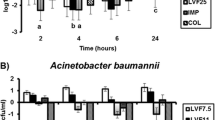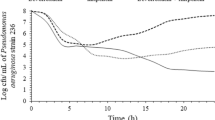Abstract
In empirical antibacterial therapy, regional surveillance is expected to yield important information for the determination of the class and dosage regimen of antibacterial agents to be used when dealing with infections with organisms such as Pseudomonas aeruginosa, in which strains resistant to antibacterial agents have been increasing. The minimal inhibitory concentrations (MICs) of five carbapenem antibiotics against P. aeruginosa strains isolated in the Northern Kyushu district of Japan between 2005 and 2006 were measured, and 100 strains for which carbapenem MICs were ≤0.5–32 μg/ml were selected. In this study, MIC was measured by two methods, i.e., the common serial twofold dilution method and an integrated concentration method, in which the concentration was changed, in increments of 2 μg/ml, from 2 to 16 μg/ml. The MIC50/MIC90 values for imipenem, meropenem, biapenem, doripenem, and panipenem, respectively, with the former method were 8/16, 4/16, 4/16, 2/8, and 16/16 μg/ml; and the values were 6/10, 4/12, 4/10, 2/6, and 10/16 μg/ml with the latter method. The MIC data obtained with both methods were subjected to pharmacokinetic/pharmacodynamic (PK/PD) analysis with Monte Carlo simulation to calculate the probability of achieving the target of time above MIC (T>MIC) with each carbapenem. The probability of achieving 25% time above the MIC (T>MIC; % of T>MIC for dosing intervals) and 40% T>MIC against P. aeruginosa with any dosage regimen was higher with doripenem than with any other carbapenem tested. When the two sets of MIC data were subjected to PK/PD analysis, the difference between the two methods in the probability of achieving each % T>MIC was small, thus endorsing the validity of the serial twofold dilution method.
Similar content being viewed by others
References
Shimojima M. Results on sensitivity of 760 000 fresh clinical isolates to various antibacterial agents, collected from various prefectures Shinryou to Shinnyaku 2006;43:697–753.
National Committee for Clinical Laboratory Standards (NCCLS). Methods for dilution antimicrobial susceptibility tests for bacteria that grow aerobically. Approved standard-sixth edition M7-A6. Wayne, PA: NCCLS: 2003.
National Committee for Clinical Laboratory Standards. MIC testing supplemental tables M100-S13. Wayne, PA: NCCLS; 2003.
Andes D, Craig WA. Animal model pharmacokinetics and pharmacodynamics: a critical review. Int J Antimicrob Agents 2002;19:261–268.
Kuti JL, Dandekar PK, Nightingale CH, Nicolau DP. Use of Monte Carlo simulation to design strategy for meropenem. J Clin Pharmacol 2003;43:1116–1123.
Mouton JW, Punt N, Vinks AA. A retrospective analysis using Monte Carlo simulation to evaluate recommended ceftazidime dosing regimens in healthy volunteers, patients with cystic fibrosis, and patients in the intensive care unit. Clin Ther 2005;27:762–772.
Nakagawa K, Koyama M, Hayase K, Kesado T. Imipenem, cilastatin sodium, imipenem/cilastatin sodium clinical phase I study. Jpn J Chemother 1985;33:357–378.
Saito R, Miura T, Tarao F, Saito K. Pharmacokinetic study on biapenem. Jpn J Chemother 1994;42:277–284.
Kuroda N, Munekage T, Yamano Y. Bactericidal activity of doripenem using in vitro pharmacodynamic models. Jpn J Chemother 2005;53:92–103.
Matsumoto H, Yokota K, Kobayashi H, editors. Thirty-ninth annual meeting of the Japanese Society of Chemotherapy. Tokyo: New drug symposium meropenem (SM-7338) booklet; 1991. p. 77–114.
Saito R, Shimada K, editors. Thirty-eighth annual meeting of the Western Chapter of the Japanese Society of Chemotherapy. Gihu: New drug symposium CS-976 booklet; 1990. p. 77–120.
Mikamo H. Optimizing meropenem therapy based on pharmacokinetics/pharmacodynamics (PK/PD) for severe infection disease. Antibiot Chemother 2005;21:105–113.
Mikamo H, Totsuka K. The proper use of carbapenem examined by Monte Carlo simulation. Jpn J Chemother 2005;58:359–367.
Craig WA. The role of pharmacodynamics in effective treatment of community-acquired pathogens. Advanced Studies in Medicine 2002;2:126–133.
Ambrose PG, Owens RC, Garvey MJ, Jones RN. Pharmacodynamics considerations in the treatment of moderate to severe pseudomonal infections with cefepime. J Antimicrob Chemother 2002;49:445–453.
Author information
Authors and Affiliations
Corresponding author
About this article
Cite this article
Nagasawa, Z., Kusaba, K. & Aoki, Y. Susceptibility of clinical isolates of Pseudomonas aeruginosa in the Northern Kyushu district of Japan to carbapenem antibiotics, determined by an integrated concentration method: evaluation of the method based on Monte Carlo simulation. J Infect Chemother 14, 238–243 (2008). https://doi.org/10.1007/s10156-008-0609-0
Received:
Accepted:
Published:
Issue Date:
DOI: https://doi.org/10.1007/s10156-008-0609-0




